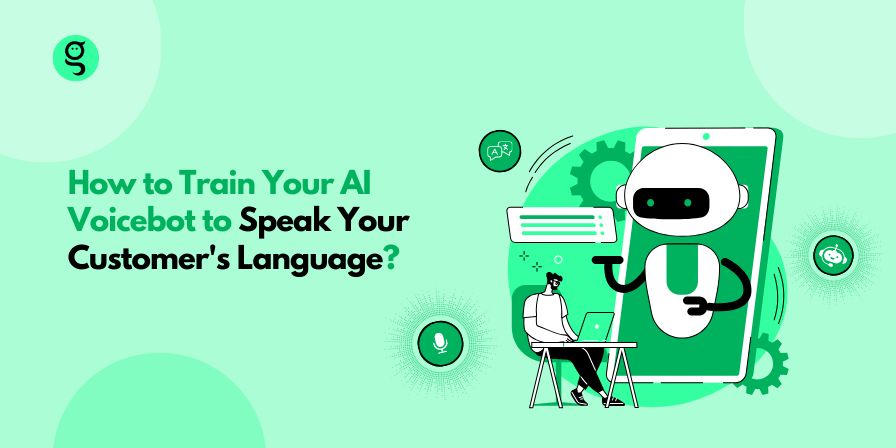In 2024, businesses are constantly seeking ways to enhance their customer service and provide a seamless customer experience. One powerful solution that can solve this problem and is increasingly being adopted by businesses worldwide is conversational voice AI.
AI-powered voice assistants have the capability to interact with customers in a natural, human-like manner in 2024. However, to truly resonate with your target audience, these voice technology solutions need to be trained to speak your customer's language, both literally and figuratively.
And in today’s blog, we’re going to look at some effective ways AI-powered voice bots can be trained to speak just like your customers want.
What Powers Voice AI?
Let us first understand the various core components of the voice AI technology. And how all of these components come together to offer the enhanced experience your customers get. Here are some of the key components:
- ASR (Automatic Speech Recognition):
Voice AI relies on ASR as its core component. It allows the system to precisely transcribe spoken words into text.
- NLP (Natural Language Processing):
NLP helps the voice bot understand the meaning and intent behind your customer's queries, enabling effective communication.
- Intent Recognition:
This component helps the voice bot understand the customer's needs, so it can respond with relevant and meaningful information.
- Personalization:
Voice bots can be trained to adapt their language style and tone to match individual industry’s customer preferences.
- Language Adaptiveness:
Voice AI can be trained to understand and communicate in multiple languages, which helps it to cater to a larger diverse customer base.
VoiceGenie itself can communicate with customers in more than 100 languages including Hindi, English, Arabic, French, Spanish, and many more.
- Emotional Intelligence/Empathy:
Advanced voice bots have the ability to recognize and react to the customer's emotions by understanding their tone and voice. This creates a more compassionate and customized experience.
7 Tips to Train Your Voice bot to Speak Your Customer's Language
1. Gather High-Quality Industry Data for Initial Training:
It is important to provide your voice bot with accurate and valuable information during its initial training phase. This includes real customer conversations, industry-specific terms, and common queries.
By exposing your voice bot to this data, it will become familiar with the language and communication patterns of your industry, which will help it in future interactions.
2. Map Your Customer's Journey For Each Query Type:
Each customer interaction is special, and their language can change based on their journey stage or the type of question they have. To effectively train your voice bot, outline the various scenarios and query types your customers may come across.
This may involve sales inquiries, technical support requests, billing questions, or general information queries. By grasping the language patterns linked to each scenario, you can teach your voice bot to offer personalized and relevant responses.
3. Incorporate Domain-Specific Vocabulary:
Every industry has its own unique vocabulary and terminology. To make sure your voice bot can communicate well with your customers, it's important to teach it the specific vocabulary of your industry.
This can include technical terms, industry jargon, and commonly used phrases. By training your voice bot with this specialized vocabulary, it will be able to understand and respond to customer queries using language they are familiar with.
4. Implement Contextual Understanding:
Language is not just about individual words; it's also about understanding the context in which those words are used. Train your voice assistant to pick up on context clues like tone, mood, and how the conversation is going. This will empower it to offer more detailed and appropriate responses, improving the overall customer experience.
5. Personalize Language Style:
Different customers have different preferences when it comes to communication styles. Some may prefer a formal tone, while others may prefer a more casual approach.
Train your voice bot to adapt its language style and tone based on individual customer preferences or segment-specific requirements. This level of personalization will enhance the natural feel of conversations.
6. Consider Ethical Restrictions:
It's crucial to consider ethical guidelines and restrictions when training your voice bot. Ensure that the language and responses are not harmful or discriminatory and that the bot follows relevant privacy and data protection regulations.
7. Continuously Learn & Adapt:
Language is constantly evolving, and customer preferences and expectations are rising sky-high every passing year. Hence, it’s important to live up to their expectation.
So to maintain the relevance and effectiveness of your voice bot, adopt continuous learning techniques. Regularly assess customer interactions, feedback, and emerging trends, and utilize this data to enhance and refine your voice bot's language capabilities, ensuring it remains a valuable customer service tool.
To Conclude:
By following these tips and training your AI voice bot effectively, you'll be able to deliver a truly personalized and engaging customer experience. Remember, the key to success is to comprehend your customers' individual requirements, preferences, and communication styles, and adapt your voice solution accordingly.
Don't miss out on the opportunity to revolutionize your customer service with VoiceGenie's cutting-edge voice AI solutions. Book a risk-free demo today and discover how our AI-powered voice assistants can elevate your brand's customer experience to new heights.

Comments